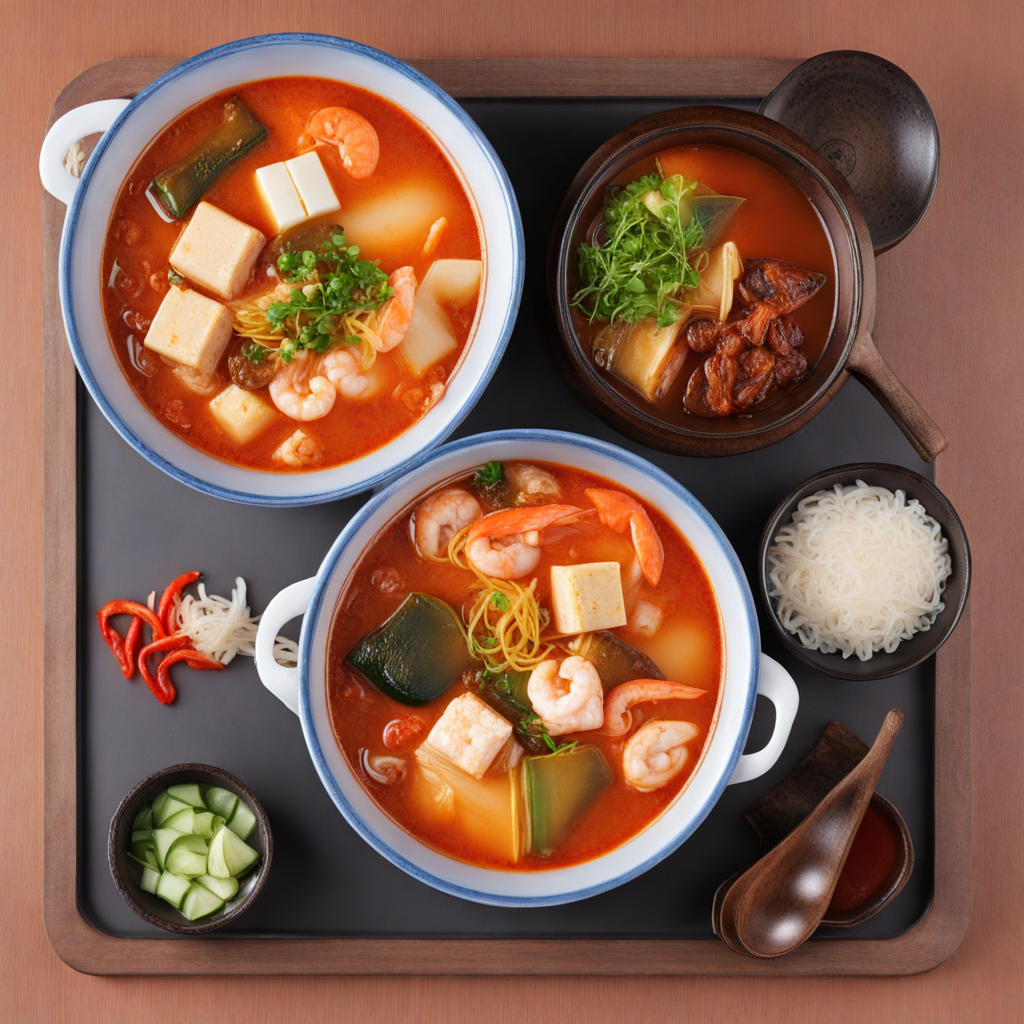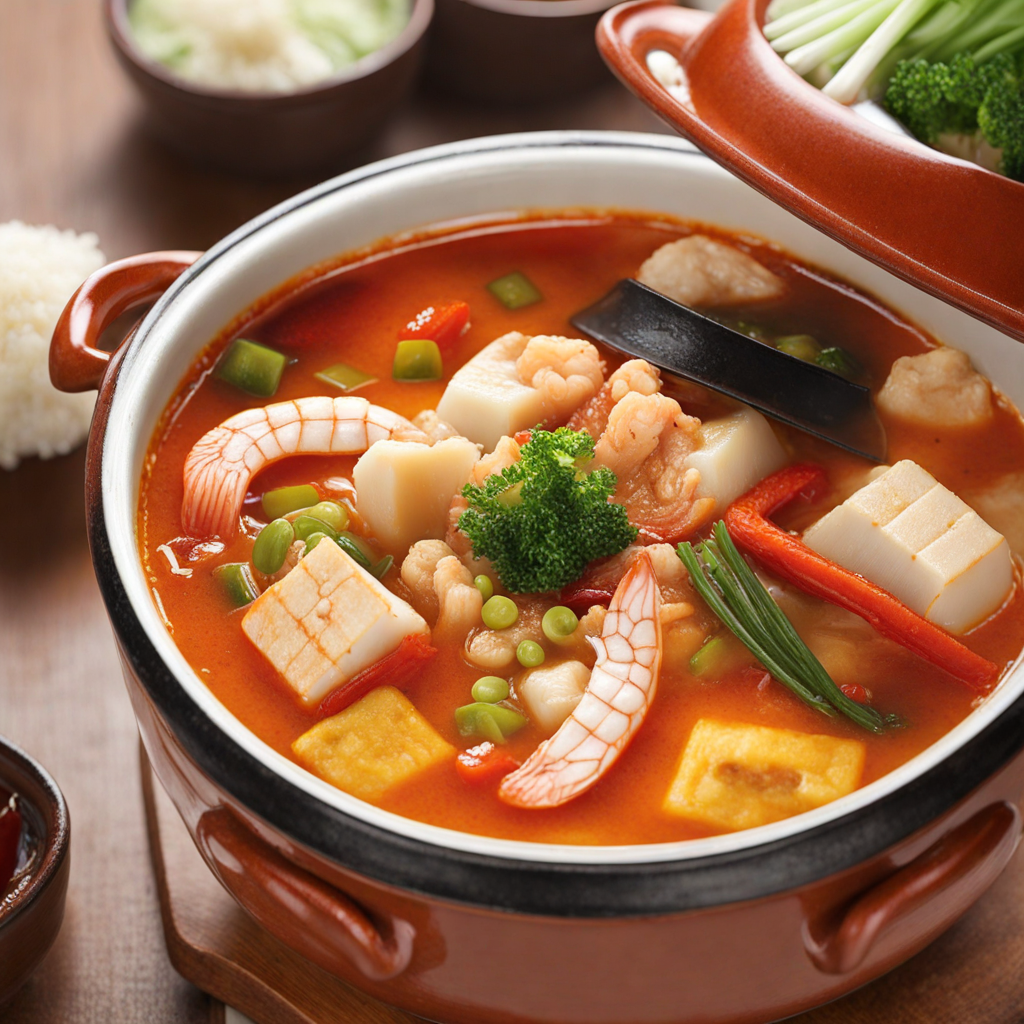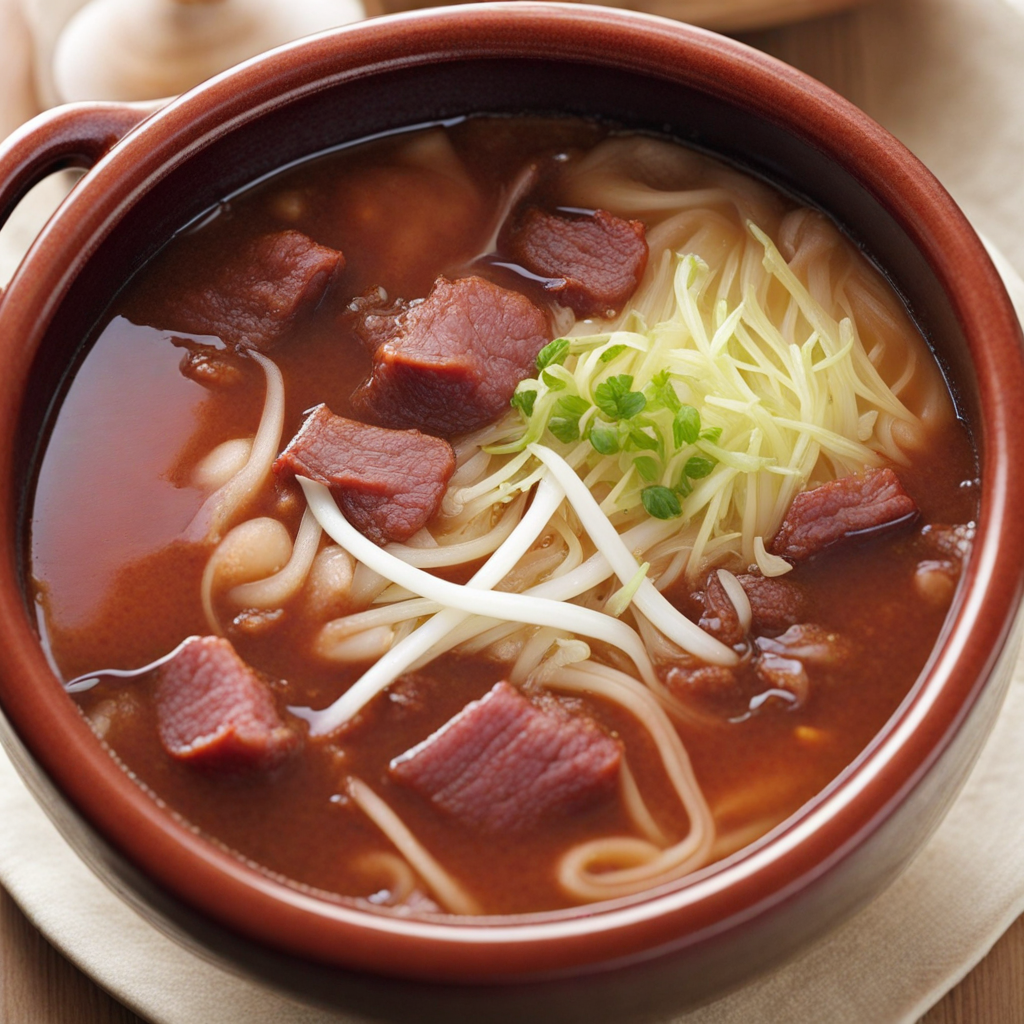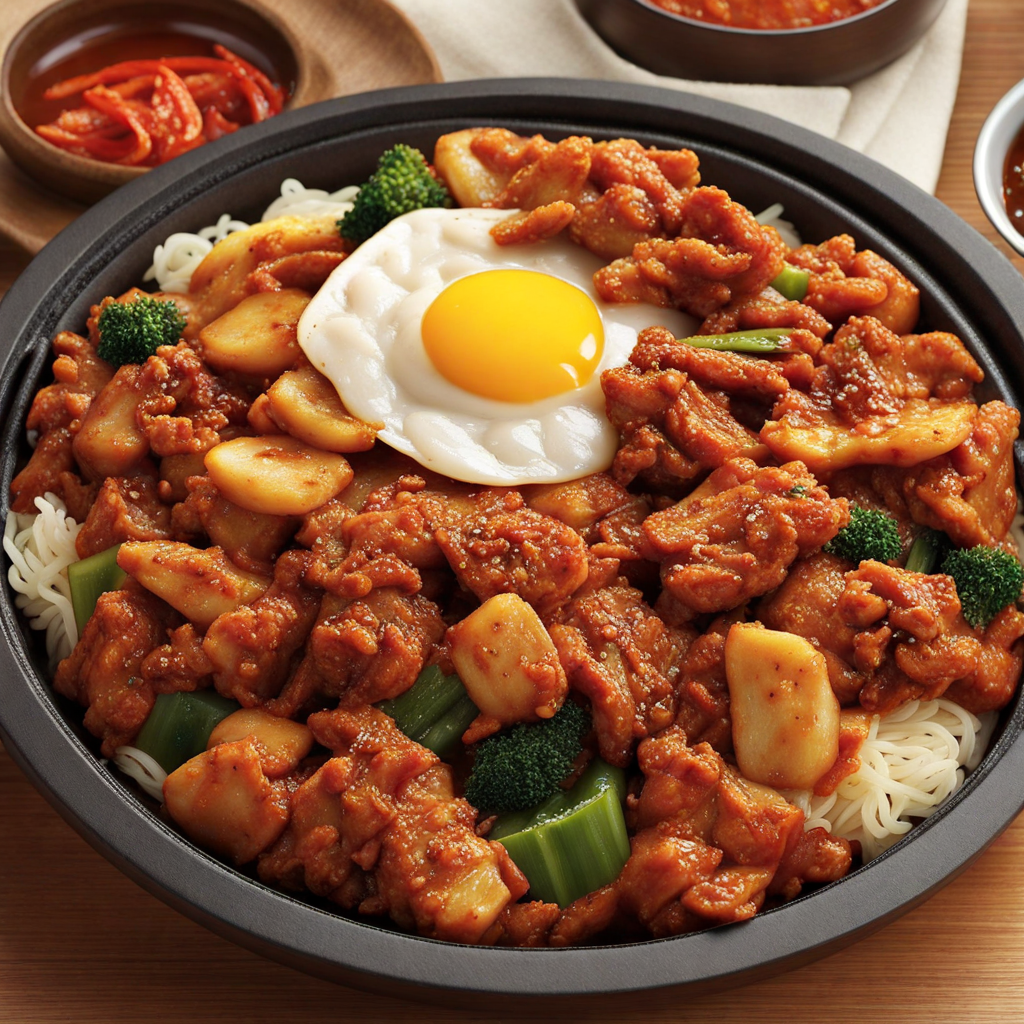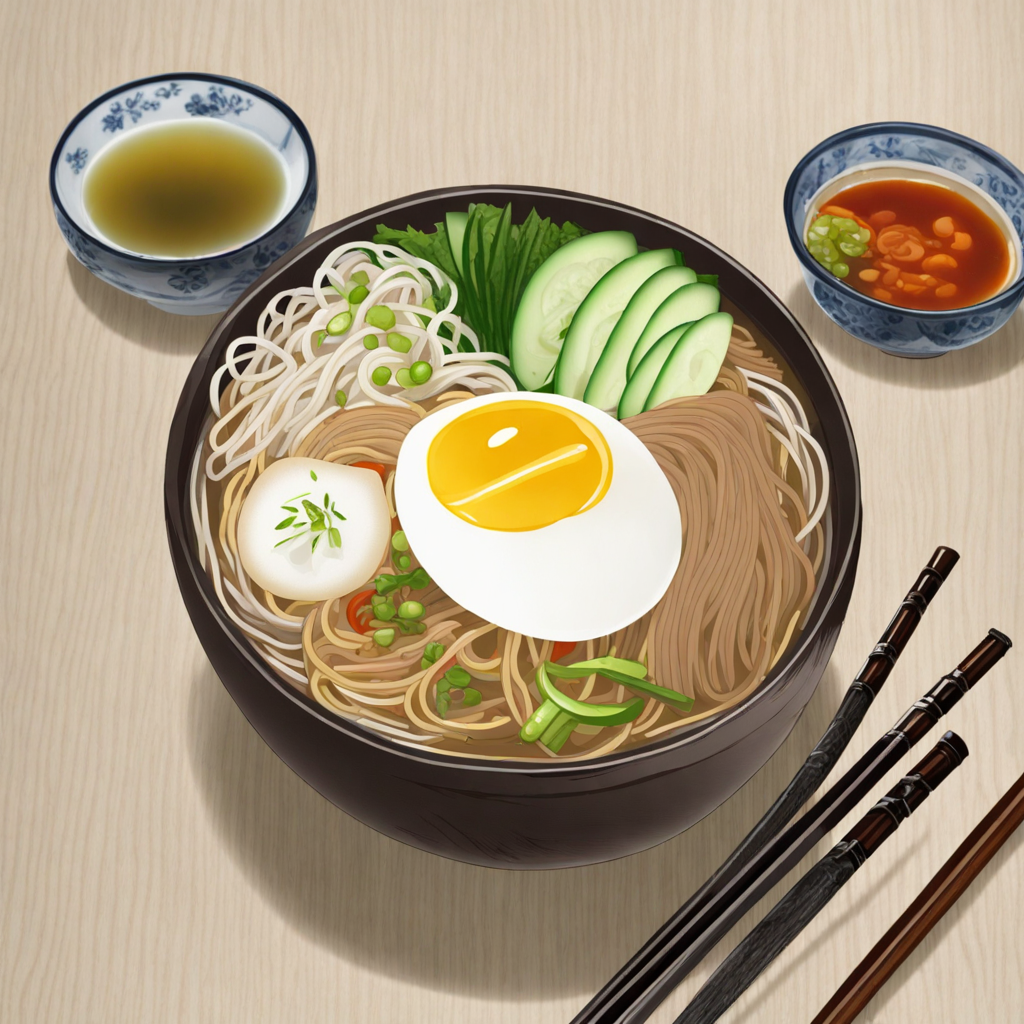Sundubu-jjigae
Sundubu-jjigae is a delightful Korean dish that celebrates the unique texture and flavor of uncurdled tofu, known as sundubu. This stew is typically made with soft, silken tofu that gently breaks apart in the hot broth, creating a creamy and comforting experience. The base of the stew usually consists of a rich and spicy gochujang (red chili pepper paste) or gochugaru (red chili flakes) combined with a savory broth made from anchovy or beef stock, which adds depth and umami. The vibrant red hue of the stew hints at its spiciness, inviting adventurous eaters to dive in and explore its complex flavors. To enhance the dish, various ingredients are added, including vegetables such as zucchini, mushrooms, and scallions, which contribute freshness and texture. Often, you will find seafood like clams or shrimp, or even meat options like beef or pork, giving the stew a hearty dimension. An egg is traditionally cracked into the bubbling broth just before serving, allowing it to poach gently and enrich the dish with its creamy yolk. This combination of ingredients creates a harmonious balance of heat, sweetness, and savory notes that tantalizes the palate. Served bubbling hot in a stone pot, sundubu-jjigae is often accompanied by a side of steamed rice and various banchan (small side dishes), which elevate the dining experience. The stew is not only a feast for the taste buds but also a warming comfort food, perfect for sharing with loved ones. Whether enjoyed on a chilly day or as a satisfying meal, sundubu-jjigae is a must-try for anyone looking to explore the rich and diverse world of Korean cuisine.
How It Became This Dish
Origin of 순두부찌개 순두부찌개, or soft tofu stew, has its roots deeply embedded in Korean culinary traditions. This dish is primarily made with 순두부 (sundubu), which is uncurdled tofu that is soft and delicate. The origins of sundubu can be traced back to ancient Korea, where tofu was introduced through the influence of Buddhism, which emphasized vegetarianism and a reliance on plant-based foods. The earliest references to tofu in Korea date back to the Goryeo Dynasty (918–1392), but it was during the Joseon Dynasty (1392–1897) that tofu became an integral part of the Korean diet. The creation of 순두부찌개 is believed to have been born out of necessity, reflecting the humble ingredients available in rural Korean households. Traditionally, the stew was prepared by farmers and laborers who sought a nourishing, warm meal that was both filling and easy to make. Given that tofu is a primary source of protein in a predominantly plant-based diet, it became a staple in many Korean homes, particularly in the Jeolla Province, where the dish gained popularity. Cultural Significance 순두부찌개 holds significant cultural importance in South Korea. It embodies the essence of Korean comfort food, often associated with family gatherings and shared meals. The dish is frequently enjoyed during colder months, as its warmth and hearty ingredients provide solace against the chill. It is common for families to gather around a pot of bubbling 순두부찌개, sharing stories and laughter, which fosters a sense of community and togetherness. Moreover, 순두부찌개 is often associated with health benefits, making it a popular choice among those seeking nutritious options. The soft tofu is rich in protein and low in calories, while the accompanying ingredients, such as vegetables and seafood, add layers of flavor and nutrition. In recent years, the dish has gained attention for its health properties, resonating with the growing global trend towards plant-based diets and wellness-oriented eating. Ingredients and Variations The basic ingredients of 순두부찌개 include 순두부, water or broth, vegetables such as zucchini and mushrooms, and seasonings like garlic, sesame oil, and gochugaru (Korean red pepper flakes). There are numerous variations of this stew, depending on regional and personal preferences. Some might include seafood, such as clams or shrimp, while others may opt for meat, like ground pork or beef. One of the most notable variations is the 김치순두부찌개 (kimchi sundubu jjigae), which incorporates fermented kimchi, adding a tangy flavor that complements the soft tofu. Another popular variation is the 해물순두부찌개 (haemul sundubu jjigae), featuring a medley of fresh seafood, showcasing the diverse marine life along Korea's coastline. Development Over Time As Korea underwent modernization throughout the 20th century, so did its culinary practices. The popularity of 순두부찌개 surged, transforming from a humble home-cooked meal into a dish featured in restaurants and eateries nationwide. The proliferation of Korean food culture globally has also contributed to its recognition outside of Korea. Today, 순두부찌개 is a staple in Korean restaurants around the world, often served as a main dish alongside rice and banchan (side dishes). The rise of Korean pop culture, particularly through K-dramas and K-pop, has further popularized 순두부찌개. Viewers are often treated to scenes of characters enjoying hearty bowls of this stew, thus inspiring food enthusiasts to seek out authentic experiences. As a result, the dish has seen its profile elevated in culinary discussions, leading to a renewed interest in traditional Korean cooking methods and flavors. Modern Interpretations In contemporary cuisine, chefs are experimenting with 순두부찌개, introducing innovative twists while maintaining its core essence. Some modern interpretations involve the use of fusion ingredients, such as truffle oil or exotic vegetables, catering to evolving palates and dietary preferences. Additionally, plant-based versions of the stew have emerged, appealing to vegans and those looking to reduce their meat consumption. Despite these modern adaptations, the traditional preparation methods continue to be respected. Many cooks emphasize the importance of using quality ingredients, particularly when it comes to the tofu. Artisanal sundubu, often made fresh and sold at specialty stores, is preferred for its creaminess and texture, reaffirming the notion that authenticity is key to enjoying this beloved dish. Conclusion: A Culinary Icon Ultimately, 순두부찌개 stands as a culinary icon of South Korea, representing not only the country's rich food heritage but also its ability to adapt and thrive in a modern context. The dish's evolution mirrors the changes in Korean society, showcasing resilience and innovation while remaining a cherished part of everyday life. Whether enjoyed in a bustling restaurant or prepared in a family kitchen, 순두부찌개 continues to warm hearts and fill bellies, proving that some dishes are timeless, transcending generations and borders. As the world becomes increasingly interconnected, 순두부찌개 will likely continue to be a symbol of Korean culture, inviting all to experience its unique flavors and the warmth it brings to the table.
You may like
Discover local flavors from South Korea


